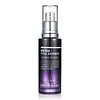What's inside
What's inside
 Key Ingredients
Key Ingredients

 Benefits
Benefits

 Ingredients Side-by-side
Ingredients Side-by-side

Water
Skin ConditioningButylene Glycol
HumectantLactobacillus/Pumpkin Ferment Extract
Skin ConditioningBifida Ferment Lysate
Skin ConditioningNiacinamide
SmoothingMethyl Gluceth-20
HumectantGlycerin
HumectantPhenoxyethanol
Preservative1,2-Hexanediol
Skin ConditioningSodium Hyaluronate
HumectantCaprylhydroxamic Acid
Aureobasidium Pullulans Ferment
Skin ConditioningAdenosine
Skin ConditioningBoswellia Serrata Resin Extract
SmoothingCamellia Sinensis Leaf Extract
AntimicrobialPanax Ginseng Root Extract
EmollientSodium Polyacrylate
AbsorbentCopper Tripeptide-1
Skin ConditioningEthylhexylglycerin
Skin ConditioningAcetyl Hexapeptide-8
HumectantWater, Butylene Glycol, Lactobacillus/Pumpkin Ferment Extract, Bifida Ferment Lysate, Niacinamide, Methyl Gluceth-20, Glycerin, Phenoxyethanol, 1,2-Hexanediol, Sodium Hyaluronate, Caprylhydroxamic Acid, Aureobasidium Pullulans Ferment, Adenosine, Boswellia Serrata Resin Extract, Camellia Sinensis Leaf Extract, Panax Ginseng Root Extract, Sodium Polyacrylate, Copper Tripeptide-1, Ethylhexylglycerin, Acetyl Hexapeptide-8
 Reviews
Reviews

Ingredients Explained
These ingredients are found in both products.
Ingredients higher up in an ingredient list are typically present in a larger amount.
1,2-Hexanediol is a synthetic liquid and another multi-functional powerhouse.
It is a:
- Humectant, drawing moisture into the skin
- Emollient, helping to soften skin
- Solvent, dispersing and stabilizing formulas
- Preservative booster, enhancing the antimicrobial activity of other preservatives
Butylene Glycol (or BG) is used within cosmetic products for a few different reasons:
Overall, Butylene Glycol is a safe and well-rounded ingredient that works well with other ingredients.
Though this ingredient works well with most skin types, some people with sensitive skin may experience a reaction such as allergic rashes, closed comedones, or itchiness.
Learn more about Butylene GlycolPhenoxyethanol is a preservative that has germicide, antimicrobial, and aromatic properties. Studies show that phenoxyethanol can prevent microbial growth. By itself, it has a scent that is similar to that of a rose.
It's often used in formulations along with Caprylyl Glycol to preserve the shelf life of products.
Sodium Hyaluronate is hyaluronic acid's salt form. It is commonly derived from the sodium salt of hyaluronic acid.
Like hyaluronic acid, it is great at holding water and acts as a humectant. This makes it a great skin hydrating ingredient.
Sodium Hyaluronate is naturally occurring in our bodies and is mostly found in eye fluid and joints.
These are some other common types of Hyaluronic Acid:
Learn more about Sodium HyaluronateSodium Polyacrylate is the sodium salt of polyacrylic acid. It is used as an absorber, emollient, and stabilizer.
This ingredient is a super-absorbent polymer - meaning it can absorb 100 to 1000 times its mass in water. As an emollient, Sodium Polyacrylate helps soften and soothe skin. Emollients work by creating a barrier to trap moisture in. This helps keep your skin hydrated.